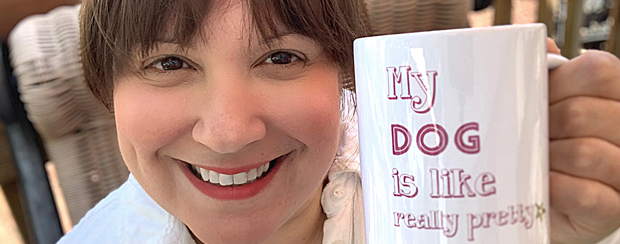Before the pandemic, I had started selling my line of fashion-forward merchandise for pet lovers at local events hosted by animal-rescue groups and other nonprofits. But when I was furloughed from my office job in 2020, I decided to turn this side hustle into an online business.
Not only did starting an ecommerce business greatly expand my potential customer base, but it also makes it far easier to promote my products and continue selling to past customers who want to buy from me again.
Unleashing opportunity
Building out my ecommerce operations was easy. I used the platform Shopify to build my website, which guided me through a step-by-step process of creating product listings and designing my site layout. It also offers video tutorials and user forums to help answer any questions along the way.
My business model thankfully lends itself to ecommerce. I work with print-on-demand companies that allow me to stay very nimble. How it works: When somebody places an order through my website, it goes directly to my supplier—who then prints the item and ships it directly to my customer. It usually takes about two days for a product to ship, though sometimes longer around the holidays.
One big benefit to this model is I’m not burdened with managing inventory and everything that entails. I can focus on marketing my products and let my suppliers deal with the logistics.
One thing I really like about Shopify is all of the analytics it provides: I always know which products are getting the most views, where site traffic is coming from and what’s getting added to people’s shopping carts. If someone abandons their shopping cart, I know that, too.
Fetching customers
As they say, “If you build it, will they come?” I’ve learned that you can have the best ecommerce site ever, but marketing is the true key to success. There’s so much competition among online retailers today that you have to look at effective strategies and tools for getting the word out about your products.
Facebook ads, for example, have been my most effective revenue generator so far. But learning the ropes of Facebook advertising and how to maximize its effectiveness takes time—and some trial and error. I took an online course through Udemy that taught me how to create an ideal Facebook ad through the use of audience targeting.
The big takeaway from the course: the more niche your product, the more powerful the ad. I can target my Facebook ads, for example, at dog owners and rescue group members, people who “like” certain large pet retailers’ Facebook pages and people within certain demographics that tend to own pets. I originally created and tested five different ads but only kept the one that generated the most solid leads. I get charged every time someone clicks on my ad and goes to my website, so I want to make sure I’m spending my ad dollars effectively.
I’ve also been building my company’s social media presence. I try to post something at least a few times a week, whether a funny pet “meme” or sharing a post about an animal in need of a home.
I belong to a wonderful networking group called Press For Success. It costs $40 a month, and it’s so worth it. They train you on how to pitch and provide information to editors and producers and how those professionals prefer to be approached. I pitched two stories that had amazing results—one with Woman’s Day magazine (a roundup of birthday gift ideas that included my pet jewelry) and another with a bank (a column about saving money on pet costs that quoted me extensively).
Looking ahead
I’m now one year into my online store, and I gross about $2,000 a month in sales and get about 800 site visitors per month. I’m always looking at new ways to expand my reach and grow sales—both online and offline.
Going forward, I’m considering promoting my products through TikTok videos, as well as selling my merchandise on Amazon—which just vetted me as a seller. I’d also like to do more partnerships with rescue groups. (Currently, 10% of my sales go to animal-rescue groups.)
“I’m always looking at new ways to expand my reach and grow sales—both online and offline.”
I’m also looking to start working with pet influencers on sites like Instagram. (Yes, that’s a thing!) And as COVID-19 lockdown restrictions continue to loosen, I am looking to create pop-up stores at local car dealerships, pet supply retailers and boutiques that have customers with demographics similar to mine.
I believe that I Love My Pet More Than You is on the cusp of becoming something really special. Above all, I want my brand to be something fun and educational. I want it to be more than just an online store—I want people to understand the value of animal rescue. If my brand can do all that, I’ll be very happy.
Print this article



trisheye@msn.com
posted 06/06/2021
Interesting article. I never realized how much went into an online store. I think having buyers linked directly to the company that does the printing is so smart in allowing you to grow your business without having inventory that you’d have to management in addition to all of your other responsibilities. Congratulations from a classmate of your mom snd dad.